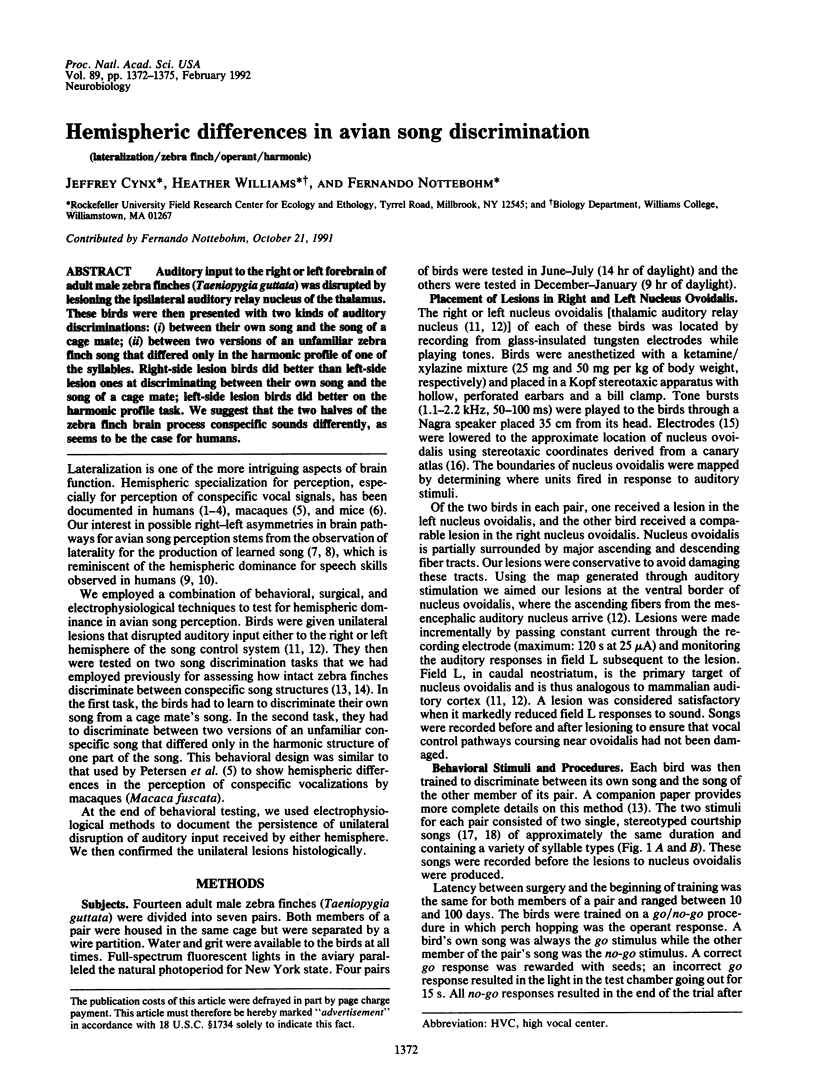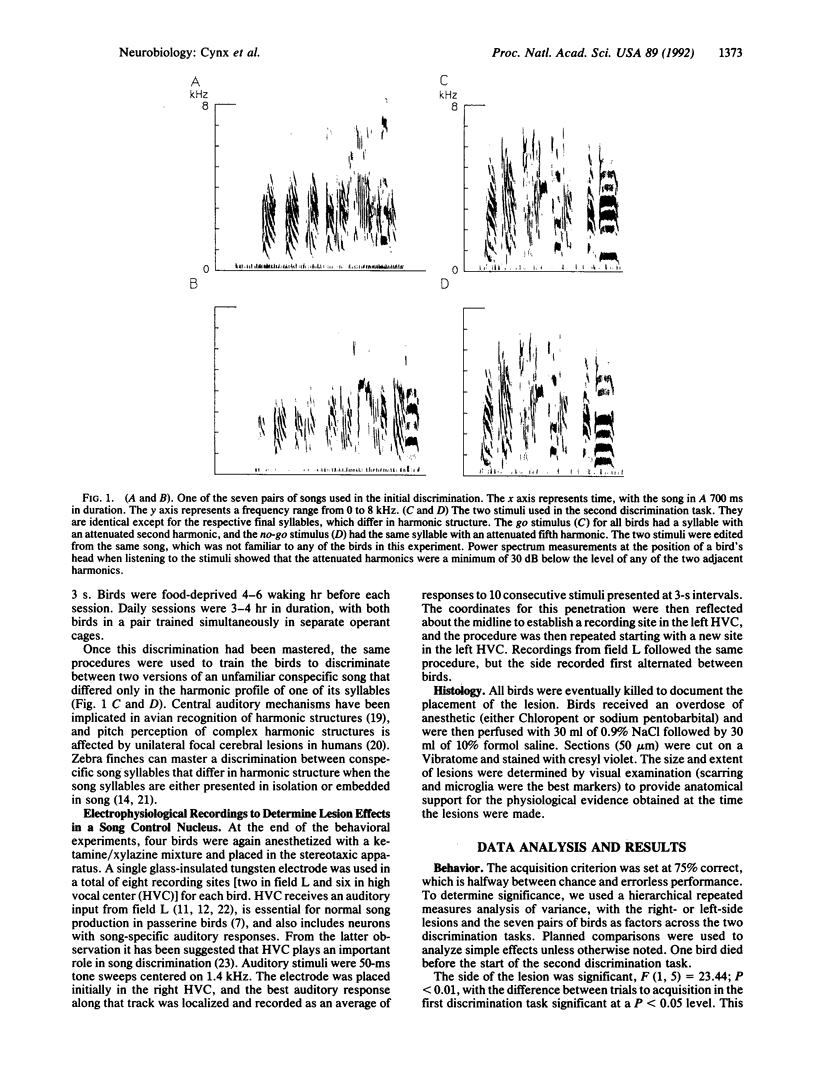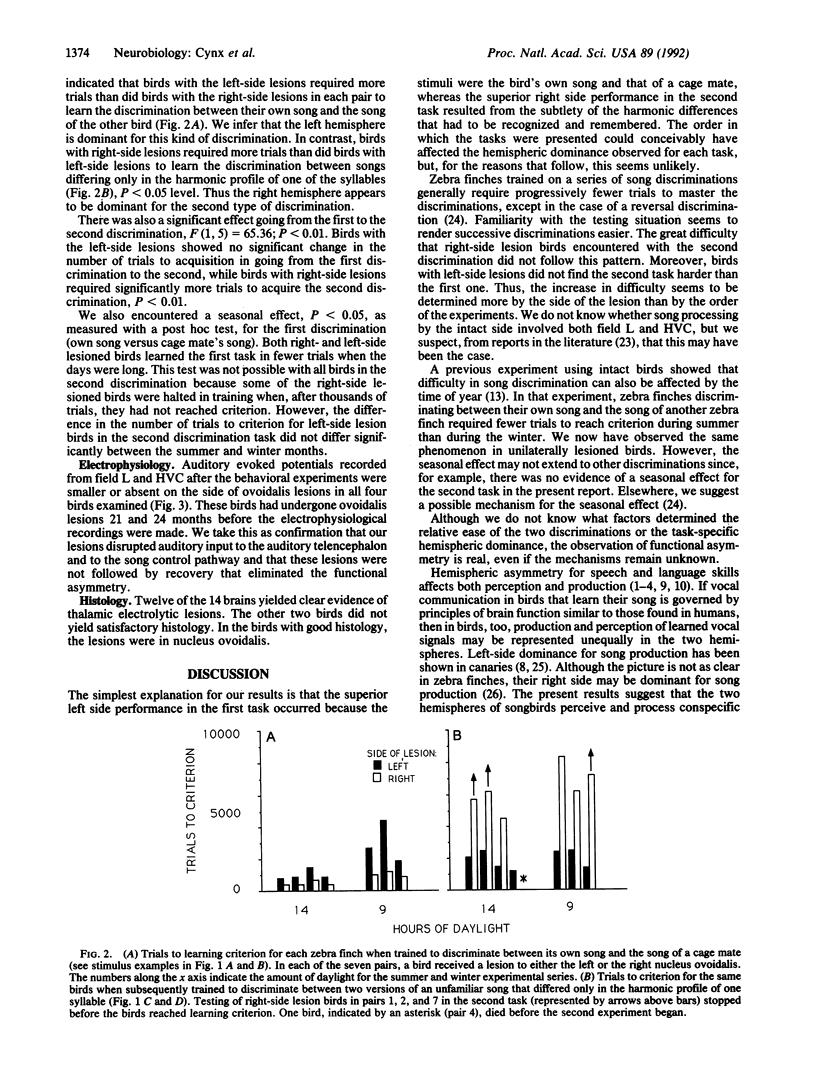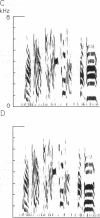Abstract
Auditory input to the right or left forebrain of adult male zebra finches (Taeniopygia guttata) was disrupted by lesioning the ipsilateral auditory relay nucleus of the thalamus. These birds were then presented with two kinds of auditory discriminations: (i) between their own song and the song of a cage mate; (ii) between two versions of an unfamiliar zebra finch song that differed only in the harmonic profile of one of the syllables. Right-side lesion birds did better than left-side lesion ones at discriminating between their own song and the song of a cage mate; left-side lesion birds did better on the harmonic profile task. We suggest that the two halves of the zebra finch brain process conspecific sounds differently, as seems to be the case for humans.
Full text
PDF



Images in this article
Selected References
These references are in PubMed. This may not be the complete list of references from this article.
- Cynx J., Nottebohm F. Role of gender, season, and familiarity in discrimination of conspecific song by zebra finches (Taeniopygia guttata). Proc Natl Acad Sci U S A. 1992 Feb 15;89(4):1368–1371. doi: 10.1073/pnas.89.4.1368. [DOI] [PMC free article] [PubMed] [Google Scholar]
- Cynx J., Nottebohm F. Testosterone facilitates some conspecific song discriminations in castrated zebra finches (Taeniopygia guttata). Proc Natl Acad Sci U S A. 1992 Feb 15;89(4):1376–1378. doi: 10.1073/pnas.89.4.1376. [DOI] [PMC free article] [PubMed] [Google Scholar]
- Cynx J., Williams H., Nottebohm F. Timbre discrimination in zebra finch (Taeniopygia guttata) song syllables. J Comp Psychol. 1990 Dec;104(4):303–308. doi: 10.1037/0735-7036.104.4.303. [DOI] [PubMed] [Google Scholar]
- Ehret G. Left hemisphere advantage in the mouse brain for recognizing ultrasonic communication calls. Nature. 1987 Jan 15;325(6101):249–251. doi: 10.1038/325249a0. [DOI] [PubMed] [Google Scholar]
- Karten H. J. The ascending auditory pathway in the pigeon (Columba livia). II. Telencephalic projections of the nucleus ovoidalis thalami. Brain Res. 1968 Oct;11(1):134–153. doi: 10.1016/0006-8993(68)90078-4. [DOI] [PubMed] [Google Scholar]
- Katz L. C., Gurney M. E. Auditory responses in the zebra finch's motor system for song. Brain Res. 1981 Sep 21;221(1):192–197. doi: 10.1016/0006-8993(81)91073-8. [DOI] [PubMed] [Google Scholar]
- Kelley D. B., Nottebohm F. Projections of a telencephalic auditory nucleus-field L-in the canary. J Comp Neurol. 1979 Feb 1;183(3):455–469. doi: 10.1002/cne.901830302. [DOI] [PubMed] [Google Scholar]
- Margoliash D. Acoustic parameters underlying the responses of song-specific neurons in the white-crowned sparrow. J Neurosci. 1983 May;3(5):1039–1057. doi: 10.1523/JNEUROSCI.03-05-01039.1983. [DOI] [PMC free article] [PubMed] [Google Scholar]
- Marler P. Birdsong and speech development: could there be parallels? Am Sci. 1970 Nov-Dec;58(6):669–673. [PubMed] [Google Scholar]
- Nottebohm F., Alvarez-Buylla A., Cynx J., Kirn J., Ling C. Y., Nottebohm M., Suter R., Tolles A., Williams H. Song learning in birds: the relation between perception and production. Philos Trans R Soc Lond B Biol Sci. 1990 Aug 29;329(1253):115–124. doi: 10.1098/rstb.1990.0156. [DOI] [PubMed] [Google Scholar]
- Nottebohm F., Stokes T. M., Leonard C. M. Central control of song in the canary, Serinus canarius. J Comp Neurol. 1976 Feb 15;165(4):457–486. doi: 10.1002/cne.901650405. [DOI] [PubMed] [Google Scholar]
- Petersen M. R., Beecher M. D., Zoloth S. R., Moody D. B., Stebbins W. C. Neural lateralization of species-specific vocalizations by Japanese macaques (Macaca fuscata). Science. 1978 Oct 20;202(4365):324–327. doi: 10.1126/science.99817. [DOI] [PubMed] [Google Scholar]
- Ross E. D. The aprosodias. Functional-anatomic organization of the affective components of language in the right hemisphere. Arch Neurol. 1981 Sep;38(9):561–569. doi: 10.1001/archneur.1981.00510090055006. [DOI] [PubMed] [Google Scholar]
- Stokes T. M., Leonard C. M., Nottebohm F. The telencephalon, diencephalon, and mesencephalon of the canary, Serinus canaria, in stereotaxic coordinates. J Comp Neurol. 1974 Aug 1;156(3):337–374. doi: 10.1002/cne.901560305. [DOI] [PubMed] [Google Scholar]
- Studdert-Kennedy M., Shankweiler D. Hemispheric specialization for speech perception. J Acoust Soc Am. 1970 Aug;48(2):579–594. doi: 10.1121/1.1912174. [DOI] [PubMed] [Google Scholar]
- Zatorre R. J. Pitch perception of complex tones and human temporal-lobe function. J Acoust Soc Am. 1988 Aug;84(2):566–572. doi: 10.1121/1.396834. [DOI] [PubMed] [Google Scholar]




